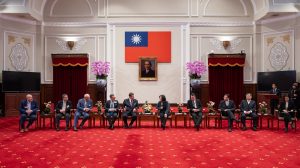When Lai Ching-te led Taiwan’s Democratic Progressive Party (DPP) to an unprecedented third term in the presidency on January 13, international commentators were quick to note two things: First, a rejection of Beijing’s “preferred candidate,” Hou Yu-ih of the Kuomintang (KMT), and, second, the deep polarization in Taiwan between the “independence-leaning” Green camp and “pro-China” Blue camp, resulting in a divided legislature.
These oversimplifications not only present a distorted view of Taiwanese politics but mask the remarkable progress Taiwan has made over 30 years of democratization and nation-building.
While the DPP has roots in the aspiration for Taiwanese independence, it has long moderated its stance on the issue, culminating in the 1999 “Resolution on Taiwan’s Future.” In that document, the DPP asserted that Taiwan does not need to declare independence, because it is already an independent country with the name Republic of China (Taiwan).
While there is plenty of daylight between the DPP and KMT, the two camps have coalesced over the years under remarkably similar positions with regards to national sovereignty. Since 1999, both parties have affirmed and defended the existence of a sovereign state named ROC (Taiwan). Although the Green camp emphasizes “Taiwan,” and the Blue camp emphasizes “ROC,” both accept the ROC (Taiwan) framework, reflecting a basic consensus across the mainstream. Neither party proposes changing the country’s name, nor declaring independence. The ROC abandoned its plans of “reconquering” the mainland in 1991, and in 2002 abandoned its claim to Mongolia.
Although both sides have long abandoned extremist positions in favor of moderate consensus-based politics, outsiders continue to view Taiwanese politics in terms of outdated tropes that paint the country as more divided and volatile than it is. Most notably, in 2011 the Obama administration in the United States interfered in Taiwan’s 2012 presidential election through media leaks declaring a lack of confidence in the ability of Tsai Ing-wen, then the DPP’s candidate, to maintain cross-strait stability.
Tsai ultimately won the following election in 2016. Her eight-year tenure reflects the fact that Taiwan, while having genuinely competitive electoral politics between parties with starkly different visions for the country, has a predominant mainstream consensus on the basic political issues that cause foreign observers so much consternation.
One disagreement has been the “1992 Consensus,” an agreement between KMT and Chinese Communist Party (CCP) representatives that Taiwan and the PRC are part of a singular “China.” The CCP has called for adherence to the 1992 Consensus as a precondition for talks, which the DPP has long rejected. Yet in 2022 KMT Chairman Eric Chu declared the 1992 Consensus a “non-consensus consensus,” obliquely rejecting it.
The only prominent figure who seems to hew strongly to the 1992 Consensus has been former President Ma Ying-jeou. Although Ma seemed to have strong influence over Hou Yu-ih, he became persona non grata at the end of Hou’s campaign after calling on Taiwan to “trust Xi Jinping.”
As Chu and Ma tussle within the KMT, today’s KMT is not simply a “pro-China” party, nor a party solely of waishengren, the descendants of colonists who arrived in 1949 and brutally suppressed Taiwan’s Taiwanese-speaking population. All three candidates this year came from Taiwan’s benshengren population, which was in Taiwan for centuries prior to the ROC’s colonization of the island. Hou can be heard speaking as much Taiwanese, which the KMT had previously banned under martial law, as much as he speaks Mandarin.
And while no ROC flags can be found at DPP rallies, the DPP will continue to fly it over the presidential office building, a 25-year policy of recognizing the sovereignty of a country called “ROC Taiwan.” This is the “non-consensus consensus” of Taiwanese politics: despite bitter divisions over domestic and foreign policy, both parties adhere to a broad political consensus.
One of the great ironies of the 2024 election is that a KMT victory may have ended up frustrating China even more. Although the KMT would likely have pursued foolhardy economic policies, allowing China to exert more influence over Taiwan, the party has clearly rejected pursuing any efforts toward “unification.” And the KMT broadly favors stronger defense cooperation with the United States. Even with its preferred partner in power, China would find Taiwan unwilling to pursue unification talks, unwilling to cut defense ties with the United States, and wavering on the 1992 Consensus.
Where would that leave China, whose President Xi Jinping has declared “reunification” to be a “historical inevitability?” At least with the KMT in opposition, China can keep telling its citizens that it is just the “separatist” DPP authorities obstructing the inevitable, and that one day Taiwan will be back on the path to unification.
Taiwan remains today, as it was before the election, a country divided along many fault lines, and it is in for a rocky four years of divided government. But it would be folly to ignore the deep currents of political moderation running through the country, and international observers and policymakers would do well to acknowledge the longstanding “non-consensus consensus” that stabilizes politics in ROC Taiwan.

































